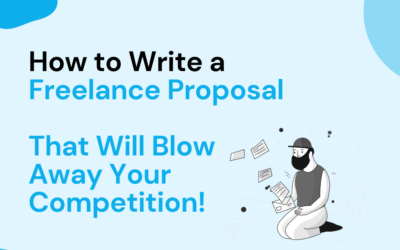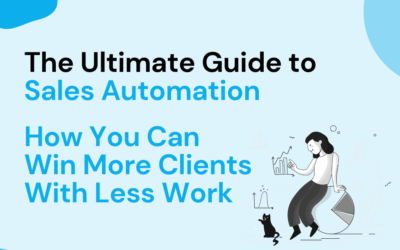It’s been three long months. You’ve done your research, toiled over every sentence, spent sleepless nights formulating the perfect business proposal. Surely, that should be enough, right?
Wrong. There is one more thing you need to do. And if you get it wrong, it could mean the last three months were for nothing — you need to do a business proposal presentation.
The one thing between your business and the finish line is a compelling presentation where you communicate the key points of your proposed solution. With so much riding on this, it’s easy to feel overwhelmed. But don’t worry: by the end of this 8-minute guide, you’ll be an expert on how to present a business proposal.
- What Is A Business Proposal?
- What Is the Purpose of A Business Proposal Presentation?
- How To Structure Your Business Proposal Presentation
- 7 Tips on How to Present a Business Proposal Presentation
- Discuss benefits over features.
- Practice incessantly and get lots of feedback.
- Anticipate and incorporate answers to the questions you’ll receive.
- Ask questions throughout to involve the audience.
- Use stories throughout your presentation.
- Provide written copies on the day of the presentation.
- Don’t lean on your slides as a crutch.
- Building a Slide Deck Your Clients Will Remember
- Get Your Business Off The Ground Today With Pure Proposals
- Frequently Asked Questions

What Is A Business Proposal?
A business proposal is a document you present to a potential client or customers that details a solution to their problem. Typically, business proposals are written documents containing information about deliverables, performance metrics, budgeting projections, expected outcomes, and more.
You’re most likely to see business proposals in a business-to-business (B2B) setting, generally to win over business clients, suppliers, and partners. A proposal can be:
- Formally Solicited: Here, you’re given a list of requirements that you must follow to a tee.
- Informally Solicited: If the client isn’t entirely sure of what the problem or pain point is, they may put out an official request for your research and solutions.
- Unsolicited: These kinds of proposals are uncommon, but they have their place in sales and marketing funnels.
What Is the Purpose of A Business Proposal Presentation?
Often, the business proposal process is a laborious one. An in-person presentation tends to be the final barrier to overcome when trying to close a deal with a client.
Typically, after sending a business proposal document, you’ll be called in to deliver a presentation about the proposal. The presentation is where potential clients can finally see the human element of all the documents and spreadsheets they’ve been scanning thus far.
If you can’t communicate the contents of your business proposal clearly through a presentation, then there’s a good chance the days, weeks, or months you’ve spent preparing the proposal could go to waste. A well-delivered proposal presentation will inspire your audience to act then and there to accept your proposition.

How To Structure Your Business Proposal Presentation
The last thing you want is for your presentation to feel too robotic and formulaic. That said, there are a few essential points you should always hit on:
- Open with the problem or need
- Offer a solution and elaborate
- Finish with a call-to-action
Let’s dive deeper into each one.
Open with the problem or need
A common mistake is to start with a 30-second spiel about you and your company. The problem? Your audience (aka potential clients) probably doesn’t care about you as much as they care about their own company’s issues. Fortunately, there’s an easy way to get past this: start by detailing their problems.
By opening with the customer’s needs vs. a self-introduction, you achieve three things:
- You demonstrate a vested interest in your clients’ success.
- You’re grabbing your audience’s attention by centering them in the presentation.
- You’ve set off a narrative structure by introducing the conflict. (More on this later).
Make sure to use facts, figures, and statistics here to drive your points home.
Offer a solution and elaborate
This will be the most comprehensive section of your presentation. Draw on the data from your written business proposal to flesh out this area, including information about project details, deliverables, performance metrics, budgets, talent, and more. It’s acceptable to follow the structure of your written proposal, but try to incorporate the details into a narrative format.
Finish with a call-to-action
You should be going into this meeting with an ask in mind — signing a contract, purchasing a bundle, scheduling the next appointment. Ideally, your presentation leads towards this CTA, so you should make it easy for your audience to follow up: include your contact information on the slide, have printed copies of the contract on hand, etc.
Now that you have a basic idea of the structure of a business proposal presentation, let’s go over some tips to elevate your presentation from good to great.

7 Tips on How to Present a Business Proposal Presentation
Discuss benefits over features.
Have you ever watched an Apple keynote delivered by Steve Jobs? Controversial as the man may have been, one thing is incontestable: he knew how to give a presentation. One of Jobs’ best tricks was to highlight benefits over features. Instead of telling you about the iPod’s internal architecture for data storage, he told you how many songs it could help you fit in your pocket. In your presentation, focus less on the technical specifications of your solution and more on the benefits it will give your client.
Practice incessantly and get lots of feedback.
Anyone who’s ever winged a presentation with zero preparation knows how frustrating it can be — you know you could do better if only you had more time. Avoid those feelings by practicing as much as you can: in the mirror, in the car, and ideally in front of people who will give you honest and constructive feedback. That leads nicely into the following tip:
Anticipate and incorporate answers to the questions you’ll receive.
There’s a good chance you’ll offer your audience a Q&A period at the end of your business proposal presentation.To avoid getting caught off-guard, get questions from a practice audience in advance. If you can seamlessly mold the answers into your presentation, incorporate them. If not, it doesn’t hurt to have an appendix section at the end of your PowerPoint that you can use to address your potential client’s concerns. Speaking of questions…
Ask questions throughout to involve the audience.
Every effective presentation starts with a hook: a startling statistic, the start of a story, an exciting discovery, or a question for the audience. A common mistake is to stop there. You want your audience engaged throughout your business proposal presentation, after all. Include questions and tone shifts at various points in your PowerPoint to give your audience a chance to participate and engage.
Use stories throughout your presentation.
Another powerful tool to keep your audience engaged is storytelling. Remember that narrative structure we mentioned earlier? Our brains are wired to process and recall information better if it’s framed in a story. The structure up above is a straightforward iteration of that: problem, solution, epilogue. You can also use smaller stories to add credibility during your presentation: customer testimonials, past achievements, and beyond.
Provide written copies on the day of the presentation.
It would be wrong to assume that every single person you’re presenting to has read the extended business proposal. That’s why it’s an excellent idea to have printed copies of the proposal ready and available when you give your presentation. It shows preparation and consideration for your client — a winning combination.
Don’t lean on your slides as a crutch.
Technology is incredible. Unfortunately, it is also unreliable. You’ve probably been in a situation where technical difficulties have sullied, even ruined, a presentation or pitch. If you grow dependent on your slides to deliver the business proposal presentation, you’ll be in trouble if (and when) you run into computer issues. Construct your presentation so that it works without any slides — it’ll keep you prepared for the worst-case scenario.

Building a Slide Deck Your Clients Will Remember
So we’ve established that over-reliance on your PowerPoint presentation is a bad idea — but that doesn’t mean you ignore it entirely. Here are five tips for selecting, designing, and building an unforgettable slide deck:
Use consistent typography. Your slide aesthetics are a crucial part of conveying professionalism and thoughtfulness to your audience. Use a legible font (Sans Serif and some Serif fonts will do the trick) with enough contrast that viewers can read if they want to.
Follow a visually appealing color palette. A well-designed slide deck will flow seamlessly with your spoken presentation, but an ugly one will distract from your speech entirely. Keep it simple and stick to three to five colors that complement each other and your brand (or even your clients’).
Vary your slide layouts. Do your best to keep your PowerPoint visually interesting. Following the same format for every slide looks boring and comes across as lazy. Try slides with lots of whitespace and a central statistic, or one that’s entirely an image. On the subject of images…
Add distinctive images over generic ones. Your viewers will remember 65% of the details you provide when an image accompanies them. Unfortunately, that effect loses power when you use grainy, low-quality, and generic photos. Choose diagrams wisely — they should complement or clarify what you’re talking about, not just show it visually.
Don’t overload with text. When most people see a slide deck filled with text, they automatically start reading it. The result? They’re no longer paying attention to you. Don’t add a word-for-word transcript to your slide — instead, summarize the key points and expand upon them verbally.
Get Your Business Off The Ground Today With Pure Proposals
You’ve got what you need to deliver a presentation that will amaze your client — all that’s left to do is present it! Show up early, speak with confidence, and have faith: you’re going to do great!.
By now, you’ve probably realized that the business proposal process is hard work. In all honesty, you probably just want to get back to the thing you love: your company.
That’s where we come in; here at Pure Proposals, our mission is to help your business thrive using PandaDoc to boost your sales, improve customer experience, and make proposals easier.
Curious to learn more? Chat with us today!
Frequently Asked Questions
How do I write a business proposal?
Your first step is to determine what the company requires from you — is it a formally solicited proposal? If not, follow traditional conventions: a title page, table of contents, executive summary, statement of need, proposed solution, explanation of capacity, projected billing and budget, and final terms and conditions. Check out our dedicated post on “How to Write a Business Proposal”.
What is in a business proposal?
A business proposal contains information regarding a client’s issues or pain points and a proposed solution on how to solve them. Business proposals tend to be data-driven and well-researched, so they may contain diagrams, graphs, and spreadsheets too.
How long should a business proposal presentation be?
Depending on the situation, varying proposal lengths are appropriate. For a more casual context, a one-pager that covers the basics is all you need. A longer document (around ten pages) is a better fit in more formal settings, such as with prospective customers.





